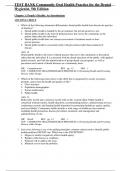Exam (elaborations)
Test Bank For Community Oral Health Practice for the Dental Hygienist, 5th Edition by Christine French Beatty
- Course
- Institution
Test Bank Community Oral Health Practice for the Dental Hygienist, 5th Edition by Christine French Beatty ISBN: 9780323683418. Community Oral Health Practice for the Dental Hygienist 5e test bank.
[Show more]



